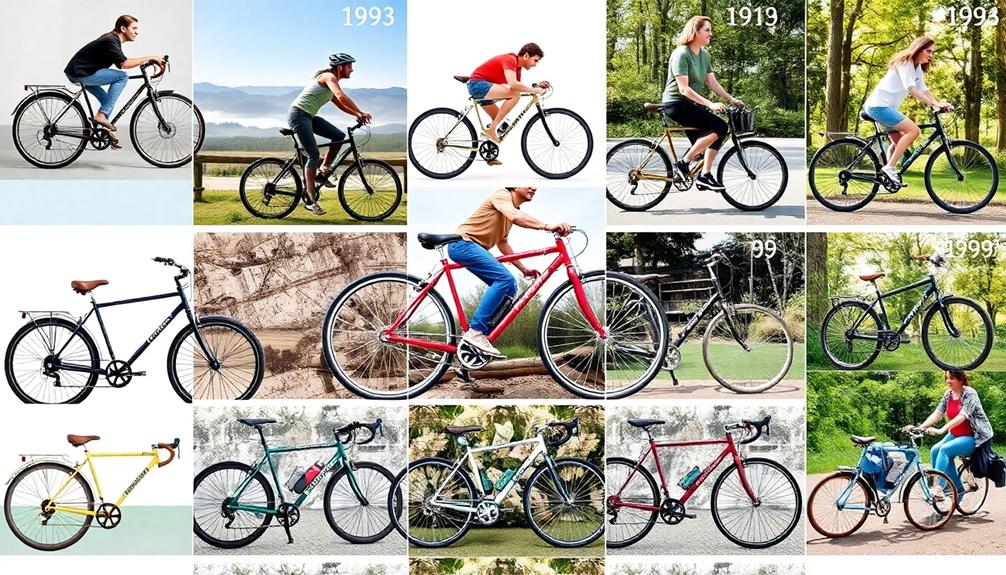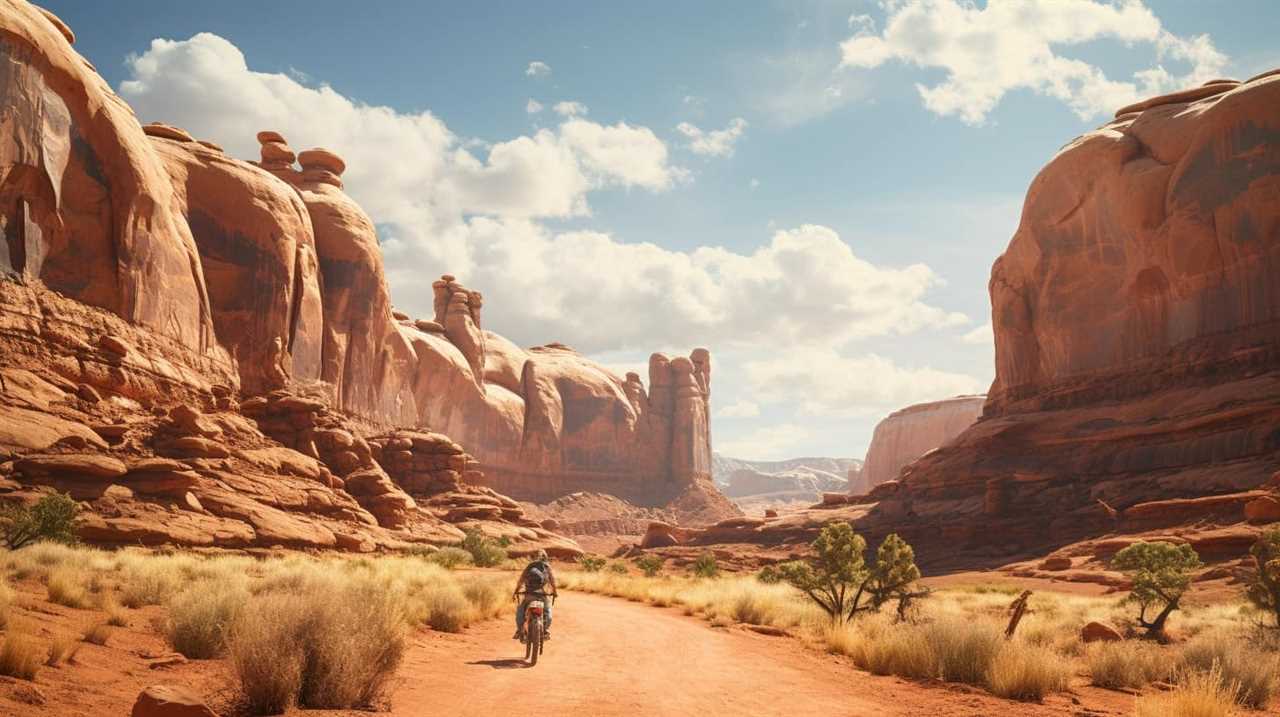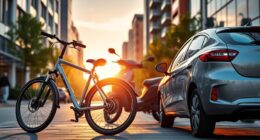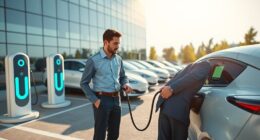Choosing between hybrid and mountain bikes depends on your riding needs. If you're commuting through the city or tackling light trails, a hybrid bike is versatile and comfortable, featuring an upright position and smoother tires. On the other hand, if you plan to ride on rugged terrain or steep climbs, go for a mountain bike with robust suspension and wider, aggressive tires for better traction. Consider your budget and maintenance needs, too, as hybrids often cost less and require less upkeep. Each bike serves different adventures, and exploring their features can guide you to the right fit for your rides.
Key Takeaways
- Hybrid bikes are ideal for urban commuting and light off-road trails, while mountain bikes excel in rugged terrains and steep climbs.
- Choose a hybrid bike for a comfortable, upright riding position and lower maintenance costs; mountain bikes offer advanced suspension for rough trails.
- Tire width and tread vary significantly: hybrids use 700c tires (32mm to 42mm) for efficiency, while mountain bikes have wider, aggressive tires for traction.
- Gearing systems differ: hybrids typically feature traditional 2x systems, whereas mountain bikes often use 1x drivetrains for steep climbs.
- Consider your budget: hybrid bikes range from $300 to $1,500, while mountain bikes start at $500 and can exceed $5,000 for high-end models.
Overview of Mountain and Hybrid Bikes
When considering your biking options, it's essential to understand the key differences between hybrid and mountain bikes. Hybrid bikes are designed for versatility, combining features from both road and mountain bikes. They excel in urban commuting and light off-road use, like gravel paths and forest trails.
With thinner, lightly treaded tires, you'll find yourself moving faster on paved roads, making them ideal for city riding. The frame geometry of hybrid bikes promotes an upright riding position, ensuring comfort during your daily commutes. Additionally, many cyclists appreciate the ability to use hybrid bikes for camping locations that are accessible via mixed terrains, allowing for spontaneous adventures.
On the other hand, mountain bikes are specifically built for rugged, off-road terrain. Their robust suspension systems and wider tires provide better grip on rocky and uneven surfaces, making them the most popular bike type in the U.S.
You'll notice that mountain bikes have heavier, thicker tires with aggressive treads, perfect for tackling soft surfaces. Their frame geometry is longer and slacker, designed for stability and control on challenging trails.
While hybrid bikes offer simpler gearing systems for flexibility, mountain bikes often use single-chainring systems, focusing on performance in steep and varied terrains. Understanding these distinctions helps you choose the right bike for your riding needs.
Key Design Differences

When you compare hybrid and mountain bikes, you'll notice key design differences that impact performance.
For instance, while hybrid bikes often feature lighter frames and smoother tires for efficient riding on varied terrains, mountain bikes are built with robust suspension systems to absorb shock on rough trails.
Suspension systems, tire design, and frame geometry are tailored for different riding experiences, so understanding these elements can help you choose the right bike for your needs.
Additionally, considering factors like high refresh rates enhance gaming experiences can influence your selection if you plan to use the bike for recreational activities that may include tech integration.
Let's explore how each design aspect sets these bikes apart.
Suspension Systems Comparison
How does the suspension system impact your riding experience? When choosing between hybrid and mountain bikes, the suspension plays a vital role. Hybrid bikes typically feature minimal or no suspension, focusing on stability and efficiency on smooth roads. In contrast, mountain bikes are equipped with advanced suspension systems that provide significant shock absorption, allowing you to conquer rugged terrains.
Here's a quick comparison of suspension systems in hybrid and mountain bikes:
| Feature | Hybrid Bikes | Mountain Bikes |
|---|---|---|
| Suspension Type | Minimal/None | Extensive Front & Rear |
| Suspension Travel | Light Front (up to 50mm) | 100mm to 200mm+ |
| Maneuverability | Limited on uneven ground | Enhanced on steep climbs |
With mountain bikes, you get features like adjustable dampers that can be fine-tuned for different terrains, improving control and comfort. While hybrids promote power transfer on paved surfaces, the flexible suspension of mountain bikes sacrifices some efficiency for better handling on uneven ground. Ultimately, your choice depends on where you plan to ride.
Tire Design Variations
The choice of tire design between hybrid and mountain bikes greatly influences your riding experience. Hybrid bikes typically use 700c tires, ranging from 32mm to 42mm in width. These tires are designed for low rolling resistance and have minimal tread, making them efficient for road performance and comfortable for urban riding.
Additionally, the lightweight nature of hybrid bikes allows for easy handling, similar to the convenience of handheld vacuums for 2025. On the other hand, mountain bikes feature much wider tires, often exceeding 2 inches (53mm-58mm), with aggressive tread patterns that enhance grip and traction on rough terrain.
When you ride a hybrid bike, you benefit from lighter, less rugged tires that excel on paved roads but struggle off-road. In contrast, mountain bike tires prioritize durability and control, allowing you to tackle challenging trails with confidence.
The tread on mountain bike tires is specifically engineered to provide traction in soft or loose conditions, while hybrid tires have a smoother surface optimized for efficiency on hard surfaces. Ultimately, understanding these tire design variations helps you make an informed decision based on your riding preferences, whether you value speed and comfort or rugged performance and control.
Frame Geometry Differences
Significant differences in frame geometry exist between hybrid and mountain bikes, directly affecting your comfort and performance.
Hybrid bikes are designed for an upright riding position, making them ideal for urban commutes and smooth rides on paved surfaces. Their geometry typically features shorter top tubes and steeper angles, optimizing efficiency while prioritizing lightweight construction for speed and easy handling.
Proper bike care, including regular maintenance, can enhance your cycling experience and longevity of the bike, much like how proper diet and care are essential for pet health.
In contrast, mountain bikes boast a slacker head angle that enhances stability and control on rough terrain. They've longer top tubes and lower bottom brackets, improving maneuverability during steep descents.
The robust frame design of mountain bikes accommodates wider tires and a suspension system, allowing for better shock absorption over uneven surfaces. This durability is essential for withstanding the rigors of off-road riding.
Suspension Features Comparison

When you compare the suspension features of hybrid and mountain bikes, you'll notice distinct differences in design and purpose.
Hybrid bikes usually offer light front suspension to smooth out small bumps, making them suitable for urban commuting and eco-friendly practices.
In contrast, mountain bikes boast more advanced systems for tackling rough terrain. This difference greatly impacts your riding comfort and control, especially on varied surfaces.
Suspension Types Overview
Exploring the suspension types in hybrid and mountain bikes reveals key differences tailored to their intended uses. Hybrid bikes typically feature light front suspension, which is designed to absorb small bumps and enhance comfort during urban rides. Additionally, they often come equipped with basic suspension systems that may not perform well on very rough surfaces, making them ideal for casual rides rather than technical trails.
In contrast, mountain bikes often come with robust front suspension and full suspension systems, engineered to handle rough trails and significant shocks. When you look at mountain bike suspension systems, they can range from 100mm to over 200mm of travel, specifically built to absorb impacts from uneven terrain.
Hardtail mountain bikes provide a balance with only front suspension, making them suitable for less technical trails, while full-suspension models offer superior comfort and control on more challenging paths. For example, the advanced design found in high-end mountain bikes allows for optimal changing gears smoothly over varying terrains, ensuring a better overall riding experience.
On the other hand, lower-end hybrid bikes may include basic suspension forks that limit performance over rough surfaces due to stiction. In contrast, high-end mountain bikes often feature advanced suspension technology that enhances shock absorption and rider control, ensuring you maintain traction and stability on rugged terrains.
Understanding these differences helps you make an informed choice based on your riding needs.
Impact on Riding Comfort
Riding comfort varies greatly between hybrid and mountain bikes, largely due to their suspension features. Hybrid bikes typically come with light front suspension that absorbs minor bumps, making your urban rides more enjoyable. They're particularly designed for commuting efficiency, which enhances comfort on city streets.
However, mountain bikes are equipped with robust front and rear suspension systems that excel in shock absorption on rough terrain. With suspension travel ranging from 100mm to over 200mm, mountain bikes handle steep descents and technical trails with ease, while hybrid bikes prioritize stability on smoother surfaces with minimal travel.
The geometry of these bikes also impacts your comfort. Hybrid bikes promote an upright riding position for easy commuting, while mountain bikes have an aggressive design that enhances control on uneven paths. Both bike types benefit from wider, supple tires, but mountain bikes outperform in traction and smoothness over rough surfaces due to their thicker tires and advanced tread patterns.
On long off-road rides, the quality and setup of mountain bike suspension greatly reduce rider fatigue, making them more suitable for extended periods on challenging trails. In contrast, hybrid bikes may require more frequent breaks on tougher paths, affecting your overall riding comfort.
Tire Specifications Explained

Tire specifications play an essential role in determining how each bike performs on different terrains. When you choose between hybrid bikes and mountain bikes, understanding these specifications can enhance your riding experience. Here's what to take into account:
1. Tire Width: Hybrid bikes typically use 700c tires with widths ranging from 32mm to 42mm, designed for low rolling resistance on paved surfaces.
In contrast, mountain bikes feature wider tires, commonly between 2.25 to 2.6 inches (about 57mm to 66mm), which provide improved traction on uneven terrains. This versatility in tire design is similar to how heat pumps offer versatility in providing both heating and cooling.
2. Tread Pattern: The tread on hybrid tires is minimal, promoting speed and comfort on roads.
Mountain bike tires, however, have deep grooves that improve grip in mud, gravel, and rocky conditions, essential for technical off-road challenges. Understanding these differences is fundamental for optimizing performance based on the riding environment.
3. Tire Pressure: Tire pressure varies greatly between the two types.
Hybrids usually run at higher pressures (50-70 psi) for efficiency, while mountain bikes operate at lower pressures (25-35 psi) to enhance shock absorption and control.
Gearing Systems Overview

When considering a bike, understanding the gearing system is essential for optimizing your ride. Hybrid and mountain bikes utilize different gearing systems tailored to their specific purposes.
Hybrid bikes typically feature traditional 2x gearing systems that offer smooth shifts on flat roads, making them ideal for urban commuting. In contrast, mountain bikes often employ 1x drivetrains with a single front chainring and wide-ratio cassettes, enabling you to tackle steep climbs and varied terrain effectively.
A well-planned budget for your bike purchase can guarantee you choose a model that fits your financial goals, as having a clear budgeting plan can prevent overspending.
Mountain bike gearing includes very low granny gears, with cogs reaching up to 50 or 52 teeth, which helps you efficiently ascend steep gradients. On the other hand, hybrid bikes are designed with a wider gear range suitable for moderate inclines and everyday riding.
The shift from triple cranksets to 1x cranksets in mountain bikes simplifies gear changes and enhances chain retention, reducing maintenance needs.
Interestingly, modern hybrids are increasingly adopting 1x drivetrains, reflecting a trend towards simplicity and reliability.
Both bike types allow for continuous cadence variation, minimizing the impact of gear jumps and enhancing your overall riding experience across diverse terrains.
Brake Types and Performance

Choosing the right bike goes beyond just the gearing system; brake types play an important role in your riding experience. Understanding the differences in brake performance can help you make an informed decision between hybrid and mountain bikes. Additionally, considering the type of terrain you'll be riding on is vital, as certain bikes are better equipped for specific environments, such as portable camping toilets for outdoor adventures.
- Brake Types: Hybrid bikes typically use rim brakes, which are lighter and simpler. In contrast, mountain bikes often feature hydraulic disc brakes, offering superior stopping power, especially in challenging conditions like mud and rain.
- Performance: Hydraulic disc brakes provide consistent performance across diverse terrains, giving you better modulation and control on steep descents and rough trails. Rim brakes may struggle under these conditions, making them less effective.
- Maintenance Needs: Rim brakes are easier to maintain and replace, ideal for casual riders. However, hydraulic disc brakes, while offering excellent performance, require more frequent servicing due to their complexity and exposure to harsh environments.
When choosing your bike, consider how you'll use it. If you're commuting in the city, rim brakes might serve you well. But if you're hitting the trails, the investment in hydraulic disc brakes can greatly enhance your riding experience.
Comfort and Riding Position

For a comfortable ride, the riding position is essential in determining how enjoyable your biking experience will be. Hybrid bikes are designed with an upright riding position that prioritizes comfort, making them perfect for urban commuting and longer casual rides. Their geometry promotes a neutral stance, allowing you to see your surroundings clearly while enjoying the ride.
On the other hand, mountain bikes feature a more aggressive forward-leaning position aimed at enhancing control and stability on rough terrains and steep descents. Here's a quick comparison of the comfort and riding positions between the two types of bikes:
| Feature | Hybrid Bikes | Mountain Bikes |
|---|---|---|
| Riding Position | Upright and relaxed | Aggressive and forward-leaning |
| Seat Design | Wider, padded for comfort | Firmer for better control |
| Stability | Good for urban surfaces | Excellent on uneven terrains |
| Best Use | City commuting and casual rides | Off-road trails and steep descents |
| Visibility | High, promotes awareness | Limited, focused on terrain |
Choosing between hybrid and mountain bikes ultimately comes down to your riding needs and preferences for comfort and stability.
Cost and Maintenance Considerations

Cost plays an essential role in deciding between hybrid and mountain bikes, as each type comes with its own financial implications. If you're on a budget, hybrid bikes are generally more budget-friendly, ranging from $300 to $1,500. In contrast, mountain bikes start at around $500 and can soar over $5,000 for high-end models.
When considering cost and maintenance, keep these points in mind:
- Maintenance Frequency: Hybrid bikes require less frequent maintenance due to their simpler design, while mountain bikes may need regular attention to suspension and drivetrain components.
- Replacement Parts: Mountain bikes often necessitate specialized parts for repairs, leading to potentially higher long-term costs compared to the straightforward components of hybrid bikes.
- Durability vs. Affordability: Investing in quality components for mountain bikes can enhance durability but also increases initial costs, whereas hybrids prioritize affordability and simplicity.
Ultimately, understanding these cost and maintenance considerations can help you make an informed choice that suits your financial situation and riding style.
User Preferences and Recommendations

When considering your riding style and preferences, it's clear that the choice between hybrid and mountain bikes often hinges on how you plan to use them. If you're commuting through the city or enjoying leisurely rides on paved roads, a hybrid bike is likely your best bet. These bikes offer versatility and comfort, allowing you to handle both smooth surfaces and light trails with ease.
On the other hand, if you're tackling rugged terrain or steep climbs, mountain bikes are designed specifically for those conditions. They provide superior traction and bike suspension, ensuring a smoother ride over rocky paths.
Here's a quick comparison to help you decide:
| Bike Type | Best For |
|---|---|
| Hybrid | Urban commuting, light trails |
| Mountain Bikes | Off-road performance, rugged terrain |
Many casual cyclists prefer hybrids for their affordability and lower maintenance needs. Meanwhile, serious trail riders are often encouraged to invest in quality mountain bikes for enhanced performance. Ultimately, think about where and how you'll ride to make the best choice for your needs.
Additional Resources for Buyers

When you're ready to make a bike purchase, several resources can guide you.
Buying guides cover everything from key features to price considerations, helping you weigh your options.
Buying Guides Overview
Choosing the right bike can feel overwhelming, but a solid buying guide can simplify the process for you.
When considering hybrid bikes vs. mountain bikes, it's crucial to understand what you need based on your riding style and terrain.
Here's a brief overview of key buying guides to help you make an informed choice:
1. Mountain Bike Buyers Guide: This guide dives into selecting the right mountain bike by focusing on terrain type, riding style, and budget.
It emphasizes important features like suspension and tire width to enhance performance.
2. Hybrid Bike Buyers Guide: This resource showcases the versatility of hybrid bikes for urban commuting and light off-road use.
It details essential specifications, including frame geometry, tire sizes, and gear options.
3. Electric Touring Bikes Buying Guide: For those interested in long-distance rides, this guide highlights the benefits of electric assistance, making your touring experience smoother and more enjoyable.
Comparing Key Features
Understanding the key features of hybrid and mountain bikes can greatly impact your decision-making process.
When it comes to tire width and tread, hybrid bikes typically have tires ranging from 28 to 42 millimeters, designed for efficiency on paved roads. In contrast, mountain bikes boast wider tires, often exceeding 2 inches, with aggressive treads that provide superior traction on rough terrain.
Suspension systems also differ considerably. Mountain bikes feature advanced systems that absorb shocks from uneven surfaces, while hybrid bikes usually have minimal or no suspension, prioritizing stability on smooth paths.
This brings us to riding position; hybrid bikes promote an upright stance for comfort during urban commutes, whereas mountain bikes offer a more aggressive geometry, enhancing control on descents and climbs.
Price Considerations
Price plays an essential role in your decision between hybrid and mountain bikes. When evaluating your options, it's important to assess various financial aspects that could impact your choice. Here are three key factors to take into account:
- Price Point: Hybrid bikes typically range from $300 to $1,500, making them more budget-friendly for casual riders. In contrast, mountain bikes start around $500 and can exceed $5,000 for high-end models.
- Maintenance Costs: Mountain bikes often incur higher long-term maintenance costs. Their rugged use may require specialized parts, while hybrid bikes usually need less frequent upkeep and replacements.
- Resale Value: If you're thinking long-term, mountain bikes tend to retain a higher resale value. Their specialized nature and demand in the cycling community make them more appealing compared to hybrid bikes, which are often viewed as entry-level.
Additionally, market availability can influence your decision. Hybrid bikes are accessible in general retailers, while mountain bikes are often found in specialized shops, affecting both pricing and options.
Understanding these factors will help you make an informed choice based on your budget and riding needs.
Frequently Asked Questions
Is a Mountain Bike or Hybrid Bike Better?
When choosing between a mountain bike or hybrid bike, consider your riding style. If you enjoy rugged trails and off-road adventures, a mountain bike's features will suit you. For urban commuting, a hybrid bike's versatility works better.
What Are the Disadvantages of Hybrid Bikes?
Hybrid bikes have disadvantages like reduced grip on rough terrain, limited shock absorption, and potentially less stability on steep descents. Their heavier weight can hinder maneuverability, making them less suitable for challenging off-road conditions.
Is Hybrid Better Than MTB?
It depends on your needs. If you're commuting or enjoying light trails, hybrids might suit you better. For rugged off-road adventures, mountain bikes excel. Consider where you'll ride most before deciding which's better for you.
Are Hybrid Bikes Ok for Off-Road?
Did you know that 60% of cyclists use hybrid bikes for light off-road adventures? While hybrids handle gravel paths well, they're not designed for tough terrains. For serious trails, you'd be better off with a mountain bike.
Conclusion
In choosing between a hybrid and a mountain bike, it's crucial to evaluate your riding style and terrain. Did you know that nearly 40% of cyclists prefer hybrid bikes for their versatility? If you're looking for a comfortable ride on both paved and rough paths, a hybrid might be your best bet. However, if you're venturing off-road and tackling rugged trails, a mountain bike will serve you well. Whatever you choose, make sure it fits your needs and style!









